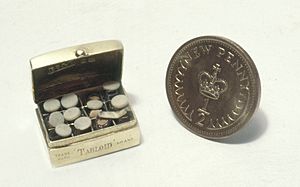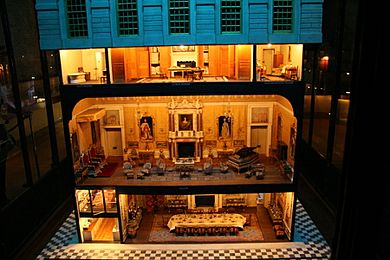Queen Mary's Dolls' House facts for kids
The Queen Mary's Dolls' House is an amazing dollhouse built in the early 1920s. It was finished in 1924 for Queen Mary, who was the wife of King George V. A famous architect named Sir Edwin Lutyens designed it. Many talented artists and craftspeople helped create it. It even has a tiny library filled with original stories by famous writers like Sir Arthur Conan Doyle and A. A. Milne.
Contents
History of the Dolls' House
The idea for this special dollhouse came from Queen Mary's cousin, Princess Marie Louise. She talked about her idea with Sir Edwin Lutyens in 1921. Sir Edwin, a top architect, agreed to build it.
Princess Marie Louise knew many artists and arranged for them to help. The dollhouse was a gift to Queen Mary from the people of England. It was also made to show how a royal family might have lived back then.
The house displayed the best and most modern items of its time. Later, the dollhouse was shown to the public to raise money for Queen Mary's charities. It was first seen at the British Empire Exhibition from 1924 to 1925. Over 1.6 million people came to see it! Today, you can visit it at Windsor Castle in Windsor, Berkshire, England.
What Makes It So Special?

This dollhouse is built to a scale of 1:12. This means one inch in the dollhouse equals one foot in real life. It stands over three feet tall! It has tiny models of products from well-known companies of that time.
The detail in the house and its tiny objects is incredible. Many items are 1⁄12-sized copies of things found in Windsor Castle. Companies or special model makers created these tiny pieces. The carpets, curtains, and furniture are all perfect copies. The house even has working lights!
The bathrooms have real running water and a toilet that flushes. It even has miniature toilet paper! Other amazing items include tiny shotguns that can "break and load." There are also monogrammed linens, working lifts, and a garage with cars that have real engines.
The Tiny Library and More
Famous writers created special books for the dollhouse's library. These tiny books were bound by Sangorski & Sutcliffe. Sir Arthur Conan Doyle wrote a short story called "How Watson Learned the Trick." The ghost-story writer M. R. James wrote "The Haunted Dolls' House." A. A. Milne, who wrote Winnie-the-Pooh, contributed "Vespers." Other famous authors like J. M. Barrie and Rudyard Kipling also wrote tiny books.
Composers also wrote miniature music for the house. These included Gustav Holst and Frederick Delius. Painters like Eli Marsden Wilson provided tiny pictures. Even the bottles in the wine cellar were filled with real, tiny amounts of wine and spirits. The wheels of the miniature cars even had proper spokes.
The Hidden Garden
There's a secret garden hidden beneath the main house. You can only see it when a large drawer is pulled out. This garden was designed by Gertrude Jekyll. It has tiny copies of plants and garden tools. It looks just like a traditional ornamental garden.


